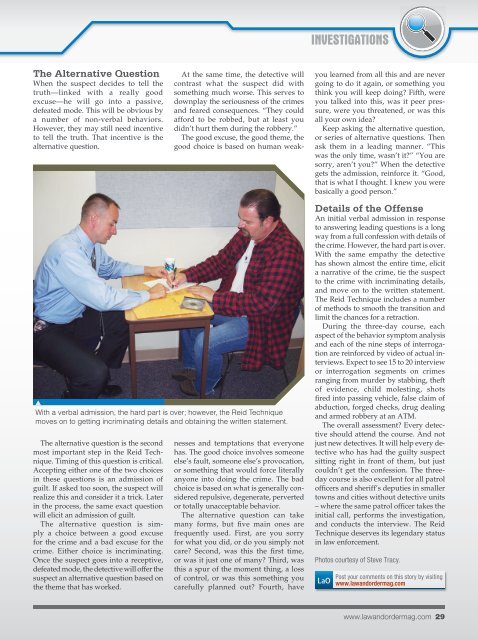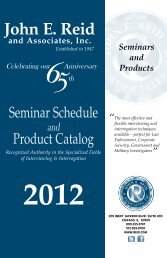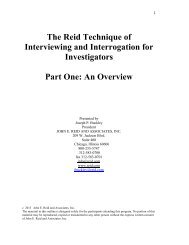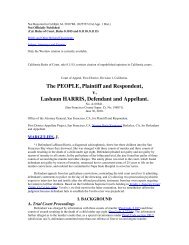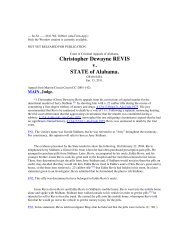THE REID TECHNIQUE OF
INTERVIEWING AND INTERROGATION - The Reid Technique of ...
INTERVIEWING AND INTERROGATION - The Reid Technique of ...
- No tags were found...
Create successful ePaper yourself
Turn your PDF publications into a flip-book with our unique Google optimized e-Paper software.
INVESTIGATIONS<br />
The Alternative Question<br />
When the suspect decides to tell the<br />
truth—linked with a really good<br />
excuse—he will go into a passive,<br />
defeated mode. This will be obvious by<br />
a number of non-verbal behaviors.<br />
However, they may still need incentive<br />
to tell the truth. That incentive is the<br />
alternative question.<br />
The alternative question is the second<br />
most important step in the Reid Technique.<br />
Timing of this question is critical.<br />
Accepting either one of the two choices<br />
in these questions is an admission of<br />
guilt. If asked too soon, the suspect will<br />
realize this and consider it a trick. Later<br />
in the process, the same exact question<br />
will elicit an admission of guilt.<br />
The alternative question is simply<br />
a choice between a good excuse<br />
for the crime and a bad excuse for the<br />
crime. Either choice is incriminating.<br />
Once the suspect goes into a receptive,<br />
defeated mode, the detective will offer the<br />
suspect an alternative question based on<br />
the theme that has worked.<br />
With a verbal admission, the hard part is over; however, the Reid Technique<br />
moves on to getting incriminating details and obtaining the written statement.<br />
At the same time, the detective will<br />
contrast what the suspect did with<br />
something much worse. This serves to<br />
downplay the seriousness of the crimes<br />
and feared consequences. “They could<br />
afford to be robbed, but at least you<br />
didn’t hurt them during the robbery.”<br />
The good excuse, the good theme, the<br />
good choice is based on human weaknesses<br />
and temptations that everyone<br />
has. The good choice involves someone<br />
else’s fault, someone else’s provocation,<br />
or something that would force literally<br />
anyone into doing the crime. The bad<br />
choice is based on what is generally considered<br />
repulsive, degenerate, perverted<br />
or totally unacceptable behavior.<br />
The alternative question can take<br />
many forms, but five main ones are<br />
frequently used. First, are you sorry<br />
for what you did, or do you simply not<br />
care? Second, was this the first time,<br />
or was it just one of many? Third, was<br />
this a spur of the moment thing, a loss<br />
of control, or was this something you<br />
carefully planned out? Fourth, have<br />
you learned from all this and are never<br />
going to do it again, or something you<br />
think you will keep doing? Fifth, were<br />
you talked into this, was it peer pressure,<br />
were you threatened, or was this<br />
all your own idea?<br />
Keep asking the alternative question,<br />
or series of alternative questions. Then<br />
ask them in a leading manner. “This<br />
was the only time, wasn’t it?” “You are<br />
sorry, aren’t you?” When the detective<br />
gets the admission, reinforce it. “Good,<br />
that is what I thought. I knew you were<br />
basically a good person.”<br />
Details of the Offense<br />
An initial verbal admission in response<br />
to answering leading questions is a long<br />
way from a full confession with details of<br />
the crime. However, the hard part is over.<br />
With the same empathy the detective<br />
has shown almost the entire time, elicit<br />
a narrative of the crime, tie the suspect<br />
to the crime with incriminating details,<br />
and move on to the written statement.<br />
The Reid Technique includes a number<br />
of methods to smooth the transition and<br />
limit the chances for a retraction.<br />
During the three-day course, each<br />
aspect of the behavior symptom analysis<br />
and each of the nine steps of interrogation<br />
are reinforced by video of actual interviews.<br />
Expect to see 15 to 20 interview<br />
or interrogation segments on crimes<br />
ranging from murder by stabbing, theft<br />
of evidence, child molesting, shots<br />
fired into passing vehicle, false claim of<br />
abduction, forged checks, drug dealing<br />
and armed robbery at an ATM.<br />
The overall assessment? Every detective<br />
should attend the course. And not<br />
just new detectives. It will help every detective<br />
who has had the guilty suspect<br />
sitting right in front of them, but just<br />
couldn’t get the confession. The threeday<br />
course is also excellent for all patrol<br />
officers and sheriff’s deputies in smaller<br />
towns and cities without detective units<br />
– where the same patrol officer takes the<br />
initial call, performs the investigation,<br />
and conducts the interview. The Reid<br />
Technique deserves its legendary status<br />
in law enforcement.<br />
Photos courtesy of Steve Tracy.<br />
LaO<br />
Post your comments on this story by visiting<br />
www.lawandordermag.com<br />
www.lawandordermag.com 29<br />
Law_Nov_Focus.indd 29<br />
12/14/2011 1:37:33 PM


